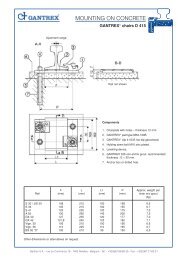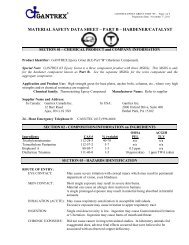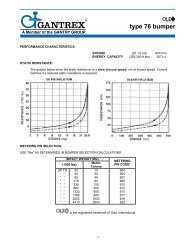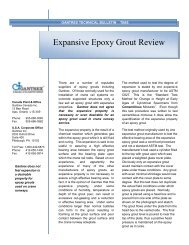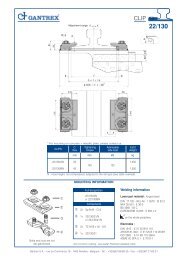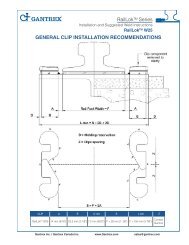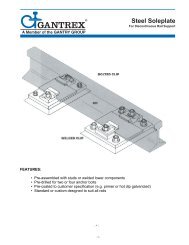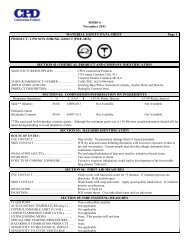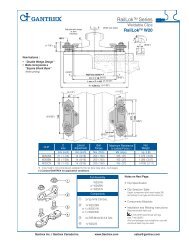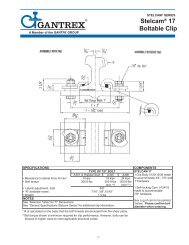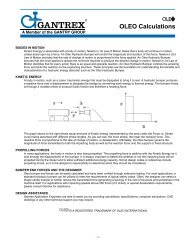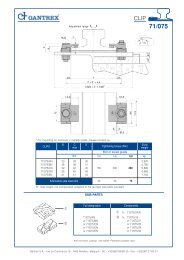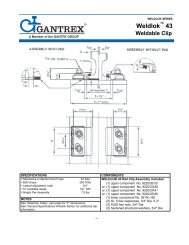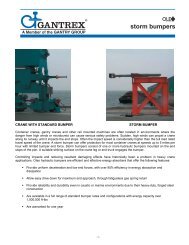Gantrex Technical Bulletin #47: Crane Rail Inspection
Gantrex Technical Bulletin #47: Crane Rail Inspection
Gantrex Technical Bulletin #47: Crane Rail Inspection
- No tags were found...
Create successful ePaper yourself
Turn your PDF publications into a flip-book with our unique Google optimized e-Paper software.
PAGE 3 of 3 GANTREX TECHNICAL BULLETIN No. TB47 <strong>Crane</strong> <strong>Rail</strong> <strong>Inspection</strong>Absent any otherreplacement criteria,the 25% rule shouldbe used as a worstcase scenario.rail when it was new. This can be doneby referencing specification sheets forthe given rail size, or by simplymeasuring the rail at a point, such asthe very ends that see little or no cranetravel.<strong>Rail</strong> wear gauge, butonly for railroad rails.Contact <strong>Gantrex</strong> at:1-800-242-6873 orwww.<strong>Gantrex</strong>.com<strong>Rail</strong> Wear TypesThe two most common types of railwear are plastic deformation and edgewear. Each will occur in every crane railapplication, the severity of whichdepends on the loading and duty cycleof a particular runway. Both types ofwear actually displace or remove metalfrom the rail surface. The results of thiswear over a long period of time canweaken the rails to the point that furtherdamage may occur, leading to failure.Obvious Signs of <strong>Crane</strong> <strong>Rail</strong> FailureThere are several failures of crane railthat can be easily identified by a visualinspection of the rail. These includebreaks in the rail, cracks in the rail headand propagating cracks from splice boltholes.Other obvious signs include theaforementioned bottoming of railsweeps and end trucks caused bysevere wear of the rail over long periodsof use. By the time these conditions arediscovered, the cost and downtime ofemergency repairs is high, and a bettermethod to determine when a rail shouldbe changed is needed.Perhaps the simplest way to determinethe amount of wear on a crane rail is tomeasure the dimensions of the rail andcompare them to the dimensions of theThe 25% RuleOne possible method to determine theamount of allowable rail wear is basedon the wheel load charts found in theWhiting <strong>Crane</strong> Handbook. It can bederived that if a given rail loses 25% ofits overall mass, the rail selection woulddrop one complete rail size category,based solely on the mass of the smallerrail as it pertains to the wheel load. Saidin another way, if a rail is worn to theextent that 25% of its mass is hasdisappeared, the wheel load wouldexceed the amount listed for that railsize. While this is a basic principle, itcan serve as a ‘lower limit’ of rail fitnessfor duty. Actual values may vary, basedon the completion of the research, butone large crane manufacturer alreadyuses this criteria when training craneinspectors regarding rail inspection.From a practical view, the point at whicha given heavy rail should be replaced ismost likely well before an aggregateloss of material. According to the FRAstudy, a 0.5” loss of head dimensionalone would account for 25% of the railmass alone. Absent any obviouscracking or damage, the 25% rule couldbe used as a maximum amount ofallowable rail wear.ConclusionFurther study to determine moreexacting values of replacement shouldbe considered by the various technicalcommittees responsible for crane, railand runway design. END.Rev 0 = 4/24/12



